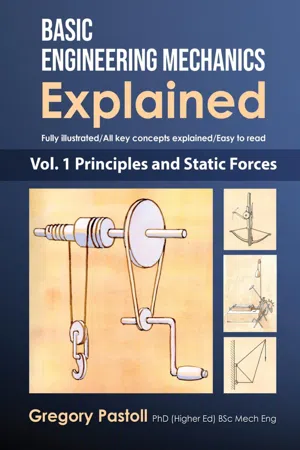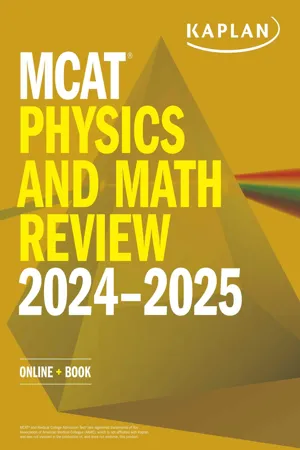Mathematics
Standard Form
Standard form in mathematics refers to a way of writing numbers as the product of a number between 1 and 10 and a power of 10. It is often used to represent very large or very small numbers in a concise and standardized format. In standard form, the number is written as a decimal multiplied by a power of 10.
Written by Perlego with AI-assistance
Related key terms
4 Key excerpts on "Standard Form"
- eBook - ePub
Basic Engineering Mechanics Explained, Volume 1
Principles and Static Forces
- Gregory Pastoll, Gregory Pastoll(Authors)
- 2019(Publication Date)
- Gregory Pastoll(Publisher)
Chapter 3 Working with numbers in engineering• Engineering notation, as opposed to scientific or ordinary notation• The number of significant figures in a value• Required format of answers for engineering purposes• Loss of accuracy when rounding off numbers during a calculation• The units that apply to mechanical quantities in the S.I. system• The difference between precision and accuracy• The limitations of precision in a primarily practical science• Converting the units of quantities, e.g. miles per hour to metres per second• Units preferred by engineersAn engineering student needs to know how to write and interpret numbers for the purposes of engineering. At some stage in your career, you will be writing lab and other types of investigative reports, performing calculations, and showing the results of your calculations. It is essential to get to know the conventions.Engineering notation, as opposed to scientific or ordinary notation Any given number can be expressed in three ways: ordinary arithmetic notation, scientific notation, and engineering notation.Ordinary arithmetic notation is what comes up on your calculator readout when you key in a sequence of digits. For example: 86.5 or 374.29 or 128502.972Scientific notation is a way of writing a number in terms of multiples of powers of ten. For example: 1.284 × 104 or 4.932 × 1017 or 7.996 × 10−6 . In scientific notation, the aim is to express the number as compactly as possible. Only one digit is allowed in front of the decimal point, and any multiple of powers of 10 can be used.Often, however, numbers expressed in scientific notation, though mathematically valid, are not conveniently practical for engineers to work with. For this reason, engineering notation was developed.Consider the number, in ordinary notation: 154 300. A scientist would write it as 1.543 x 105, whereas an engineer would write it as 154.3 x 103. If both are mathematically correct, what’s the difference, and why is there a difference? - eBook - ePub
Science and Technical Writing
A Manual of Style
- Philip Rubens(Author)
- 2002(Publication Date)
- Routledge(Publisher)
- Place a decimal point to the right of the first nonzero digit in the number,
- Delete all nonsignificant zeros (see 7.38 ), and
- Multiply the resulting number by the power of ten required to make the product equal to the original number.
Thus:247,000,000 becomes 2.47 108 in scientific notation, and0.000014647 becomes 1.4647 10–5 .7.29 The exponent (the power of ten) can be negative or positive depending on whether the number being represented is smaller or larger than 1 (the number 1 is equal to ten to the zero power). A factor of 100 is customarily omitted. Various examples of small or large numbers and their equivalents in scientific notation include 27.5 2.75 × 10 (not 2.75 × 101 ) 1.375 1.375 (not 1.375 × 100 ) 37,040,000 3.704 × 107 (assuming the trailing zeros are not significant) 2,000,000 2 × 106 (not 2.0 × 106 )(assuming the trailing zeros are not significant) 0.000715 7.15 × 10-4 0.09004 9.004 × 10-2 0.000000000145 1.45 × 10-10 10.07 1.007 × 10 7.30 The factor preceding the power of ten, the “mantissa,” is normally between one and ten, as in the preceding examples. However, there is an alternative convention of representing numbers in scientific notation so that the power of ten is a multiple of three. This practice fits the structure of the prefixes used in the International System of Units (see 7.41 ). When this convention is used, the mantissa will be between 1 and 999:149.598 × 106 km (not 1.495 98 108 - eBook - ePub
Linear Algebra
An Inquiry-Based Approach
- Jeff Suzuki(Author)
- 2021(Publication Date)
- CRC Press(Publisher)
2Systems of Linear Equations
In this chapter, we’ll consider the problem of solving systems of linear equations. This is a critical part of linear algebra, and we offer the following general strategy:Strategy. Every problem in linear algebra begins with a system of linear equations.2.1 Standard Form
When trying to work with a collection of objects, it’s easiest if they’re all in some standardized format. You’ve seen such standardized formats before: it’s convenient to rewrite a given quadratic equation in the forma; it’s convenient to write the equation of a line in the formx 2+ b x + c = 0y = m x + b; and so on. In this activity, we’ll develop a Standard Form for a system of linear equations.Activity 2.1: Standard Form We’ll say that an equation has been reduced to simplest form if it has as few terms as possible.A2.1.1 The equation3 x − 5 y = 8has three terms: 3x, 5y, and 8. If possible, rewrite the equation so it has fewer terms; if not possible, explain why not.A2.1.2 The equation2 x + 7 z = 1 + 2 y + 5 xhas five terms. If possible, rewrite the equation so it has fewer terms; if not possible, explain why not.A2.1.3 The equation5 x − 2 y + z + 12 = 0has five terms. If possible, rewrite the equation so it has fewer terms; if not possible, explain why not.Activity 2.1 motivates the following definition:Definition 2.1 (Standard Form). A linear equation is in Standard Form when- All of the variables are on one side of the =,
- The constant is on the other side of the =.
As Activity 2.1 shows, equations in Standard Form will have fewer terms than equations not in Standard Form.In Activity A1.3.2, we represented linear equations as vectors. If we have a system of equations, we can represent the entire system as a collection of vectors and, as long as all - No longer available |Learn more
MCAT Physics and Math Review 2024-2025
Online + Book
- (Author)
- 2023(Publication Date)
- Kaplan Test Prep(Publisher)
In this chapter, we reviewed many of the skills that are necessary for successful performance on the MCAT science sections. We began by examining relevant arithmetic calculations for Test Day, including scientific notation and significant figures. We continued our review by examining logarithms and exponents before discussing the most common trigonometric functions and their values. We finished our math review by working on problem-solving skills that will be valuable in your studying and during the MCAT itself. In the next two chapters, we’ll review Test Day skills in experimental design and data analysis so that you’ll be ready ready to answer all of the Test Day questions.GO ONLINE
You’ve reviewed the content, now test your knowledge and critical thinking skills by completing a test-like passage set in your online resources!CONCEPT SUMMARY
Arithmetic and Significant Figures
- Scientific notation is a method of writing numbers in a way that improves the ease of calculations and the comparability of significant digits.
- Scientific notation takes the format [significand] × 10[exponent] .
- The significand must be greater than or equal to 1 and less than 10.
- The exponent must be an integer.
- Significant figures include all nonzero digits and any trailing zeroes in a number with a decimal point.
- Measurements are an exception, in that the last digit provided is not significant.
- In addition and subtraction, reduce the answer to have the same number of decimal places as the number with the fewest number of decimal places.
- In multiplication and division, reduce the answer to have the same number of significant digits as the number with the fewest number of significant digits.
- The entire number should be maintained throughout calculations to minimize rounding error.
- Estimation of multiplication and division should be done logically.
- In multiplication, if one number is rounded up, the other should be rounded down in proportion.
- In division, if one number is rounded up, the other should also be rounded up in proportion.
Exponents and Logarithms
- Exponents
Index pages curate the most relevant extracts from our library of academic textbooks. They’ve been created using an in-house natural language model (NLM), each adding context and meaning to key research topics.



